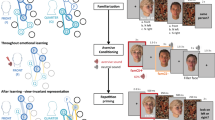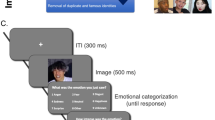Abstract
It has been proposed that facial expression production originates in sensory regulation. Here we demonstrate that facial expressions of fear are configured to enhance sensory acquisition. A statistical model of expression appearance revealed that fear and disgust expressions have opposite shape and surface reflectance features. We hypothesized that this reflects a fundamental antagonism serving to augment versus diminish sensory exposure. In keeping with this hypothesis, when subjects posed expressions of fear, they had a subjectively larger visual field, faster eye movements during target localization and an increase in nasal volume and air velocity during inspiration. The opposite pattern was found for disgust. Fear may therefore work to enhance perception, whereas disgust dampens it. These convergent results provide support for the Darwinian hypothesis that facial expressions are not arbitrary configurations for social communication, but rather, expressions may have originated in altering the sensory interface with the physical world.
This is a preview of subscription content, access via your institution
Access options
Subscribe to this journal
Receive 12 print issues and online access
$209.00 per year
only $17.42 per issue
Buy this article
- Purchase on Springer Link
- Instant access to full article PDF
Prices may be subject to local taxes which are calculated during checkout






Similar content being viewed by others
References
Fridlund, A.J. Human Facial Expression: An Evolutionary View (Academic Press, San Diego, California, 1994).
Izard, C.E. Human Emotions (Plenum, New York, 1977).
Ekman, P. Darwin and Facial Expression: A Century of Research in Review (Academic Press, New York, 1973).
Ekman, P. & Friesen, W. Constants across cultures in the face and emotion. J. Pers. Soc. Psychol. 17, 124–129 (1971).
Hess, U., Blairy, S. & Kleck, R.E. The influence of facial emotion displays, gender, and ethnicity on judgments of dominance and affiliation. J. Nonverbal Behav. 24, 265–283 (2000).
Marsh, A.A., Ambady, N. & Kleck, R.E. The effects of fear and anger facial expressions on approach- and avoidance-related behaviors. Emotion 5, 119–124 (2005).
Ekman, P. Basic emotions. in The Handbook of Cognition and Emotion (ed. Dalgleish, T. & Power, T.) 45–60 (John Wiley & Sons, Sussex, UK, 1999).
Izard, C.E. Innate and universal facial expressions: evidence from developmental and cross-cultural research. Psychol. Bull. 115, 288–299 (1994).
Adolphs, R. Recognizing emotion from facial expressions: psychological and neurological mechanisms. Behav. Cogn. Neurosci. Rev. 1, 21–62 (2002).
Gallese, V. Before and below 'theory of mind': embodied simulation and the neural correlates of social cognition. Philos. Trans. R. Soc. B. Biol. Sci. 362, 659–669 (2007).
James, W. What is an emotion? Mind 9, 188–205 (1884).
Strack, F., Martin, L.L. & Stepper, S. Inhibiting and facilitating conditions of the human smile: a nonobtrusive test of the facial feedback hypothesis. J. Pers. Soc. Psychol. 54, 768–777 (1988).
Singer, T. The neuronal basis and ontogeny of empathy and mind reading: review of literature and implications for future research. Neurosci. Biobehav. Rev. 30, 855–863 (2006).
Frijda, N.H. The Emotions (Cambridge University Press, New York, 1986).
Darwin, C. The Expression of the Emotions in Man and Animals (Oxford University Press, New York, 1872/1998).
Pieper, A. Cerebral Function in Infancy and Childhood (Consultants Bureau, New York, 1963).
Piderit, T. Mimik und Physiognomik (Detmold, Klingenberg, Germany, 1867).
Gratiolet, P. De la Physionomie et des Mouvements d'Expression (Hetzel, Paris, 1865).
Davis, M. & Whalen, P.J. The amygdala: vigilance and emotion. Mol. Psychiatry 6, 13–34 (2001).
Whalen, P.J. et al. Masked presentations of emotional facial expressions modulate amygdala activity without explicit knowledge. J. Neurosci. 18, 411–418 (1998).
Anderson, A.K., Christoff, K., Panitz, D., De Rosa, E. & Gabrieli, J.D. Neural correlates of the automatic processing of threat facial signals. J. Neurosci. 23, 5627–5633 (2003).
Phelps, E.A., Ling, S. & Carrasco, M. Emotion facilitates perception and potentiates the perceptual benefits of attention. Psychol. Sci. 17, 292–299 (2006).
Pourtois, G., Thut, G., Grave de Peralta, R., Michel, C. & Vuilleumier, P. Two electrophysiological stages of spatial orienting towards fearful faces: early tempero-parietal activation preceding gain control in extrastriate visual cortex. Neuroimage 26, 149–163 (2005).
Vuilleumier, P., Richardson, M.P., Armony, J.L., Driver, J. & Dolan, R.J. Distant influences of amygdala lesion on visual cortical activation during emotional face processing. Nat. Neurosci. 7, 1271–1278 (2004).
Rozin, P. & Fallon, A.E. A perspective on disgust. Psychol. Rev. 94, 23–41 (1987).
Dailey, M.N., Cottrell, G.W., Padgett, C. & Adolphs, R. EMPATH: a neural network that categorizes facial expressions. J. Cogn. Neurosci. 14, 1158–1173 (2002).
Susskind, J.M., Littlewort, G., Bartlett, M.S., Movellan, J. & Anderson, A.K. Human and computer recognition of facial expressions of emotion. Neuropsychologia 45, 152–162 (2007).
Scherer, K. Appraisal considered as a process of multi-level sequential checking. in Appraisal Processes in Emotion: Theory, Methods, Research (eds. Scherer, K.R., Schorr, A. & Johnstone, T.) 92–120 (Cambridge University Press, Cambridge, 2001).
Matsumoto, D. & Ekman, P. Japanese and Caucasian facial expressions of emotion (JACFEE) [Slides]. (Intercultural and Emotion Research Laboratory, Department of Psychology, San Francisco State University, San Francisco, California, 1988).
Cootes, T., Edwards, G. & Taylor, C. Active appearance models. IEEE Trans. Pattern Anal. Mach. Intell. 23, 681–685 (2001).
Leopold, D.A., O'Toole, A.J., Vetter, T. & Blanz, V. Prototype-referenced shape encoding revealed by high-level aftereffects. Nat. Neurosci. 4, 89–94 (2001).
Adolphs, R. et al. A mechanism for impaired fear recognition after amygdala damage. Nature 433, 68–72 (2005).
Whalen, P.J. et al. Human amygdala responsivity to masked fearful eye whites. Science 306, 2061 (2004).
Ruch, T.C. & Fulton, J.F. Medical Physiology and Biophysics (W.B. Saunders Company, Philadelphia, 1960).
Ekman, P. An argument for basic emotions. Cogn. Emot. 6, 169–200 (1992).
Zelano, C. & Sobel, N. Humans as an animal model for systems-level organization of olfaction. Neuron 48, 431–454 (2005).
Zajonc, R.B. Emotion and facial efference: a theory reclaimed. Science 228, 15–21 (1985).
Saussure, F.d. Course in General Linguistics (McGraw-Hill Book Company, New York, 1966).
Scherer, K.R. & Wallbott, H.G. Evidence for universality and cultural variation of differential emotion response patterning. J. Pers. Soc. Psychol. 66, 310–328 (1994).
Eibl-Eibesfeldt, I. The expressive behavior of the deaf-and-blind-born. in Social Communication and Movement (eds. von Cranach, M. & Vine, I.) 163–193 (Academic Press, New York, 1973).
Galati, D., Scherer, K.R. & Ricci-Bitti, P.E. Voluntary facial expression of emotion: comparing congenitally blind with normally sighted encoders. J. Pers. Soc. Psychol. 73, 1363–1379 (1997).
Andrew, R.J. Evolution of facial expression. Science 142, 1034–1041 (1963).
Marsh, A.A., Elfenbein, H.A. & Ambady, N. Nonverbal “accents”: cultural differences in facial expressions of emotion. Psychol. Sci. 14, 373–376 (2003).
Marsh, A.A., Adams, R.B. Jr. & Kleck, R.E. Why do fear and anger look the way they do? Form and social function in facial expressions. Pers. Soc. Psychol. Bull. 31, 73–86 (2005).
Tracy, J.L . & Robbins, R.W . Show your pride: evidence for a discrete emotion expression. Psychol. Sci. 15, 194–197 (2004).
Tooby, J. & Cosmides, L. The past explains the present: emotional adaptations and the structure of ancestral environments. Ethol. Sociobiol. 11, 375–424 (1990).
Boiten, F. Autonomic response patterns during voluntary facial action. Psychophysiology 33, 123–131 (1996).
Acknowledgements
We thank J. Pratt for comments on the eye-tracking data, F. Tam for technical assistance acquiring structural MRI scans and N. Sobel for comments on a prior draft. This work was supported by the Canada Research Chairs program and a Natural Sciences and Engineering Research Council grant to A.K.A.
Author information
Authors and Affiliations
Contributions
J.M.S. and A.K.A. contributed equally to this work. J.M.S. created and analyzed the facial appearance model and associated behavioral data. J.M.S. and A.K.A. collected and analyzed the structural MRI data. A.C. and W.G. collected and analyzed the respiration and visual-field data and wrote parts of the corresponding Methods sections. D.H.L. and R.F. collected and analyzed the objective perimetry data, and J.M.S. and R.F. collected and analyzedthe eye-tracking data. J.M.S. and A.K.A. created the figures and wrote the final manuscript.
Corresponding authors
Supplementary information
Supplementary Text and Figures
Supplementary Methods (PDF 105 kb)
Rights and permissions
About this article
Cite this article
Susskind, J., Lee, D., Cusi, A. et al. Expressing fear enhances sensory acquisition. Nat Neurosci 11, 843–850 (2008). https://doi.org/10.1038/nn.2138
Received:
Accepted:
Published:
Issue Date:
DOI: https://doi.org/10.1038/nn.2138
This article is cited by
-
A database of heterogeneous faces for studying naturalistic expressions
Scientific Reports (2023)
-
A Risk or an Opportunity? Facial Expressions of Fear in Bargaining
Evolutionary Psychological Science (2023)
-
Passive identification of subjective preferences toward individual items using eye-tracking in a virtual reality environment
Virtual Reality (2023)
-
To study the effect of a newly developed emotion detection and grading system software for identifying and grading expressions of patients with Parkinson’s disease
Multimedia Tools and Applications (2023)
-
Infrequent facial expressions of emotion do not bias attention
Psychological Research (2023)



